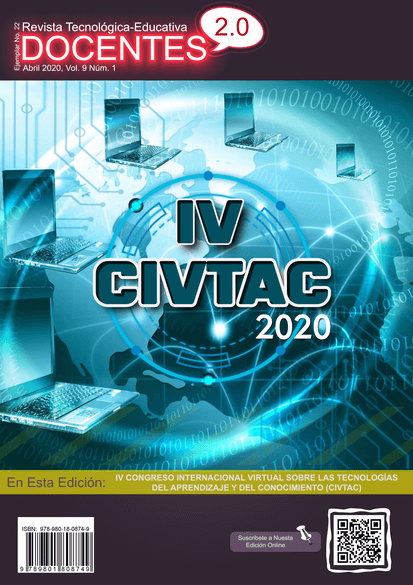The pedagogy of the image to promote meaningful learning within the classroom
 DOI:
https://doi.org/10.37843/rted.v9i1.90
DOI:
https://doi.org/10.37843/rted.v9i1.90
Main Article Content
Abstract
Image Pedagogy (IP) is proposed as the most suitable way to promote meaningful learning within the classroom. The elements that underpinned this proposal arise from field research, of a descriptive nature. The participating group was made up of 5 teachers assigned to the Chair of Environmental Education (EA) of the Pedagogical Institute of Caracas (IPC). The data collection techniques and tools were: a) the survey for diagnosis and feasibility accompanied by the questionnaire and (b) the observation and the questionnaire for the validation of the strategies designed. The results were analyzed from descriptive statistics, concluding that: (a)Teachers intuitively use IP but do not have a theoretical foundation that allows its effective application and (b) the proposal meets the pedagogical criteria for its future application, which is why its implementation is recommended by teachers who aspire to respond to the demands of today’s society.
Downloads
Metrics
Article Details

This work is licensed under a Creative Commons Attribution-NonCommercial-NoDerivatives 4.0 International License.
Those authors who have publications in our journal accept the following terms:
- When a work is accepted for publication, the author retains rights of reproduction, distribution of his/her article for exploitation in all countries of the world in the format provided by our magazine and any other magnetic medium, optical, and digital.
- Authors will retain their copyright and guarantee the journal the right first to publish their work, which will be simultaneously subject to the Creative Commons Acknowledgment License (Attribution-NonCommercial-NoDerivatives 4.0 International (CC BY-NC-ND 4.0)). That allows third parties to copy and redistribute the material in any medium or format, under the following conditions: Acknowledgment - You must properly acknowledge authorship, provide a link to the license, and indicate if any changes have been made. You may do so in any reasonable way, but not in a way that suggests you have the licensor's endorsement or receive it for your use. NonCommercial - You may not use the material for a commercial purpose. NoDerivatives - If you remix, transform, or build from the material, you cannot broadcast the modified material. There are no additional restrictions - You cannot apply legal terms or technological measures that legally restrict you from doing what the license allows.
- Authors may adopt other non-exclusive license agreements to distribute the published version of the work (e.g., deposit it in an institutional archive or publish it in a monographic volume) provided that the initial publication in this journal is indicated.
- Authors are allowed and recommended to disseminate their work through the Internet (e.g., in institutional telematic archives, repositories, libraries, or their website), producing exciting exchanges and increasing the published work's citations.
- Request of withdrawal an article has to be done in writing by the author to the Editor, becoming effective after a written response from the Editor. For this purpose, the author or authors will send correspondence via e-mail: [email protected].
- The author will not receive financial compensation for the publication of his work.
- All Docentes 2.0 Journal publications are under the Open Journal System (OJS) platform at: https://ojs.docentes20.com/.
References
Araya, F., Avalos, P., Orellana, I & Pérez, R. (2007). Metodología de la enseñanza de la historia. Universidad de la Serena, Chile.
Augustowsky, G. (2011). Imagen y enseñanza, educar la mirada. Buenos Aires.
Basto, S. (2004). El uso de la Imagen dentro de la Pedagogía de la Comunicación para Dinamizar los Procesos de Enseñanza Aprendizaje en la Asignatura Medios Didácticos de la Universidad de Industrial de Santander. Bucaramanga.
Devoto, E. (2013). La imagen como documento histórico-didáctico: algunas reflexiones a partir de la fotografía. Revista de Educación. 4(6), 73-96. https://fh.mdp.edu.ar/revistas/index.php/r_educ/article/view/753
Díaz, A. (2009). Imagen y pedagogía. http://www.redalyc.org/articulo.oa?id=322227570009
Dondis, D. (2008). La sintaxis de la imagen. Introducción al alfabeto visual. Gustavo Gili.
Dussel, I., Abramowski, A., Igarzábal, B. & Laguzzi, G. (2010). Aportes de la Imagen en la Formación Docente: Abordaje Conceptual y Pedagógico. Instituto Nacional de Formación Docente. Proyecto Red de Centros de Actualización e Innovación Educativa.
Flames, A. (2012). Trabajo de Grado Cuantitativo y Cualitativo. https://editorialubv.files.wordpress.com/2013/05/libro-trabajo-de-grado.pdf
Henríquez, A. (2007) ¿Cómo analizar una imagen? Universidad de las Américas.
Hernández, S., Fernández, C. & Baptista, L. (2010). Metodología de la Investigación. McGraw-Hill.
Llorente, E. (2000). Las Imágenes en la Enseñanza. Revista de Psicodidáctia. 9(4), 119-135.
Pericot, J. (2002). Mostrar para decir, la imagen en contexto. Barcelona: Aldea Global.
Prendes, M. (1995). ¿Imagen Didáctica o Uso Didáctico de la Imagen? Universidad de Murcia.
Rigo, D. (2014). Aprender y enseñar a través de imágenes: Desafío Educativo. Universidad Nacional de Rio Cuarto.
Sánchez, H. (2009). Una Imagen Enseña más que Mil Palabras: ¿Ver o Mirar? Revista del Instituto de Estudios Superiores en Educación Universidad del Norte. 9, 202-215.
Universidad Pedagógica Experimental Libertador. (2011). Manual de trabajo de grado de Especialización y Maestría y Tesis Doctoral (4ª. ed.). Caracas: autor.






